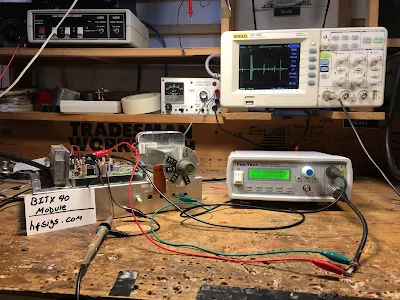On Sun, May 26, 2019 at 1:45 PM William R Meara wrote:
Dale:
I was talking to Jim W9UD on 20 SSB today. When I told him I was running a homebrew transceiver he mentioned that he talked to another guy who is on the air with homebrew SSB gear -- you!
There are so few of us Dale. I felt compelled to send you an e-mail.
What are you running?
After several years on DSB, I started building separate SSB receivers and transmitters, mostly for 17. Lately I am running versions of the Indian BITX transceiver.
Please send info on your homebrew SSB projects.
Thanks,
Bill N2CQR
Hi Bill,
I have two radios that are completed to date. I started out building the BITX 40 transceiver from scratch and also a companion 60 watt solid state linear rf amplifier. Then I decided to construct the second transceiver for 20 meter using some of the BITX design concepts and mixed with the UBITX design for additional rf amplification. It too is amplified to about 25 watts output. The 20 meter rig is my favorite radio at this time but I am going to go a different direction on my next build. It's presently just in the design stage but I'm thinking about using the MC1350 integrated circuits for the IF amplification and for the front end I may try using a FET rf amplifier. The beauty of the bitx design is the use of wide band amplifiers that don't have a tendency to oscillate. But, the new design I'm working on will have more shielding between critical circuits and I will use a small amount of negative feedback in the high gain circuits. The reason for changing the radio to a higher impedance design is to simplify the design build. I will basically build a receiver that I can reverse the signal direction over to transmit using the same amplifiers and filters. This will cut in half the amount of circuit building however it will increase the switching circuit complication associated with this new design.
Today I'm beginning the build of a 100 watt rf linear amplifier design using the kit parts from China (minipa 70) amps. This provides the transformer components and circuit boards. I purchased two kits of parts and I have a large heatsink to build it on. I'm working on a current sensing circuit for protecting the final FETS. It will run 4 IRF530's tied together with a splitter and combiner for the input and output matching transformers. It should produce at least 100 watts at 75/80 meters and maybe a little less on 40 meters but 20 meters it will drop off to about 60 or so watts.
I'm just having as much fun as a guy can have playing around with the homebrew radio's and like you say there's not many doing it these days. I love operating a radio that I built vs. running a factory made radio. I have two commercial rigs on my bench and a couple of Collins radios but the homebrew takes the lead.
Jim W9UD has become one of my ham friends this year. We end up talking every week or so on the air and keeping touch with local weather conditions.
Side Note:
I wanted to build a SSB radio since I was a young lad with a technician license in the early 60's. SSB came into the picture many years after I was first licensed. Then move forward to 2015 my ham license had long ago expired during my time in the Vietnam war. I spent several weeks studying the tech, general and finally the extra class exam information and passed on through that adventure. So I decided it's time to build my own radio from scratch. So I started to look online and in books and I still didn't have the confidence to begin building. Then I ran across Farhams BITX 40 and I thought why not buy this radio and just use it as a model of how sideband circuits work. So I did just that and I got it working fine I took the radio and placed it on the test bench and began circuit analysis and signal level evaluation until it all made perfect sense. This is accomplished while transmitting so the levels can be seen on the oscilloscope. Just kill the voltage on the final stage of the bitx. I put a 1khz signal on the mic input. That was just about the only thing I used the bitx 40 rig for and I still keep it handy when I need information.
Good hearing from you I hope I haven't over done this reply but I really enjoy talking about this subject.
73's Bill.... keep up the building and good luck on your next radio.
Dale KG7SSB
-----------------------
And of course, Pete N6QW knows Dale and has been talking about SSB with him for some time...
















































